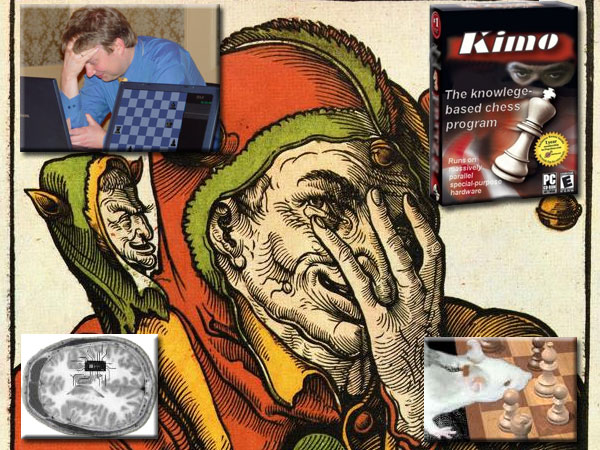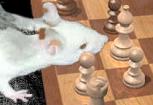


Why are we abandoning our venerable and unusually popular tradition of tricking our readers on April 1st? Over the course of two decades, it has become progressively more difficult to construct stories that do what they are supposed to: fool as many people as possible and at the same time be entertaining. We have succeeded with this fairly well in the past, but the task of actually fooling people has today become almost impossible. On April 1st armed insurgents, equipped with advanced Google searches, coordinated in forum discussions, attack our news page and post instant messages telling everybody what the April joke was and how easily they had recognised it. This in spite of the fact that we try to hide the real joke in a number of April 1st reports that sounded preposterous but were perfectly true.
But there is another reason: the Internet has become filled with fake news, churned out on an industrial scale and used to con people into buying products they do not need, adopting views that are alien to them, and even causing them to vote against their own interests in vital national elections. No, the thought of entertaining people with made-up reports no longer seems as appropriate as it once was. So instead of giving you a fake story and asking you to try and find it in today's news, we have decided to look back at past pranks, giving younger readers the opportunity to see what we were doing even before they were born.
Our news page, in its present form, was launched, coincidentally, on September 12, 2001 (before that, for a number of years, it had been a static site). Six months later, on April 1st, 2002, we published our first April Fool's jest in the current database-driven format. It claimed that the reclusive former World Champion Bobby Fischer had proposed to FIDE that a new "Fischer move" should be introduced into the rules of chess — one that allowed you to take back moves during a game and play something different. There were hundreds of letters, with quite a few readers falling for the story, among them GM Awonder Liang — no, wait, he was actually not born at that time! We already re-narrated the joke a few years ago, so anyone who missed it can read it up there.
 On April 1st 2003 we wrote a report about a project by the US National Science Foundation and other defence agencies to interface the brain directly with computer equipment. It seemed that chess would be an ideal testing ground, and the scientists working on the project decided that the hippocampus, a portion of the temporal lobe, was the ideal location for a "bionic interface". Together with a ChessBase programmer the US National Science Foundation, Office of Naval Research and Defense Advanced Research Projects Agency developed a chip which could sit on the skull of a human and communicate with the brain through two arrays of electrodes inserted into the hippocampus.
On April 1st 2003 we wrote a report about a project by the US National Science Foundation and other defence agencies to interface the brain directly with computer equipment. It seemed that chess would be an ideal testing ground, and the scientists working on the project decided that the hippocampus, a portion of the temporal lobe, was the ideal location for a "bionic interface". Together with a ChessBase programmer the US National Science Foundation, Office of Naval Research and Defense Advanced Research Projects Agency developed a chip which could sit on the skull of a human and communicate with the brain through two arrays of electrodes inserted into the hippocampus.
Schematics of the interface were given in our article. In theory, we said, the wearer would, with a little practice, be able to communicate quite efficiently with the external chess chip. Essentially only a very small amount of information needs to be communicated by the brain through the interface, and very little was needed for the response channel. After doing a prodigious amount of computing the chess chip would send a very small package of information, which would be translated by the receiver electrode array into a signal that the higher regions of the brain interpret as the visual image of a chess move.
Tests with the chip in live rats had, we claimed, already begun — with very encouraging results. In the UCLA laboratories, the scientists had installed the first bionic hippocampus interface into the brains of rats. The procedure caused only brief discomfort to the animals, who were running around their cages just an hour after it was completed.

Naturally, the rodents were not able to send any meaningful requests to the chess chips, which generated random positions and sent them at set intervals to the brains of the rats. Although they were not able to play chess, or even execute a single legal move, it turned out that rats that had the interface installed would show a clear interest in a chess board placed within their range of vision (see picture above). This did not apply to rats who had not been so treated.
What did that mean for human beings? The hippocampus has a similar structure in most mammals, so little would have to be changed to adapt the technology for humans. A full-fledged working experiment had not yet been attempted, but the prediction was that by the end of the year (2004) first working prototypes for human subjects would be ready for testing. In the end, humans would be connected to a small package consisting of a chess engine running in a matchbox-sized case. The interface itself would consist of a receiver that could be made smaller than a standard hearing aid, and the two components would use the Bluetooth protocol to communicate, making the whole setup completely unobtrusive. Since electrode arrays used in the hippocampus implants contained only microscopic amounts of metal there is no danger that they would cause metal detectors like the ones used at airports to sound alarm. The unspoken implication: this would also apply to chess tournaments.
 The feedback to the joke was quite substantial. Gabi Julien in Montreal, Canada, wrote: "No way! You got me last year about the Fischer takeback move, you won't get me this time! Please don't touch my hippothingy." Victor Graham asked: "Is the chip going to be programmed to play games with the new Fisher Retractor Move rule?" You can read a selection of readers' very entertaining comments here.
The feedback to the joke was quite substantial. Gabi Julien in Montreal, Canada, wrote: "No way! You got me last year about the Fischer takeback move, you won't get me this time! Please don't touch my hippothingy." Victor Graham asked: "Is the chip going to be programmed to play games with the new Fisher Retractor Move rule?" You can read a selection of readers' very entertaining comments here.
 Traditional chess programs blindly search millions of positions to find good moves, but it is not possible to insert enough chess knowledge to make them understand the difference between meaningful continuations and the purely nonsensical moves that they spend 99.999% of their time examining.
Traditional chess programs blindly search millions of positions to find good moves, but it is not possible to insert enough chess knowledge to make them understand the difference between meaningful continuations and the purely nonsensical moves that they spend 99.999% of their time examining.
A new chess program, we wrote on April 1st, 2004, breaks with that tradition. It works with chess knowledge derived from 20,000 master games. Kimo, created by a team of Russian programmers (hailing originally from Armenia and neighbouring republics), ran algorithms based not on a brute force search but rather on chess knowledge derived from the high-quality games. These had been extensively analysed by the program, which drew heuristic conclusions on the principles of chess: the value of the pieces in different positions, their strengths and weaknesses, attacking and defensive motifs, etc.
Kimo also conducted a traditional look-ahead, but the search was highly selective and only took into consideration "promising" lines of play. In tournament play, it generated a million times fewer moves than traditional chess engines, but was still able to hold its own against the world's strongest programs.
In our article, which you can read here, we reported that two German computer magazines had tested Kimo extensively and came to the following conclusion:
On analysis levels Kimo often finds incredible moves, which other top programs will not be able to see or understand. The openings book is tiny by today's standard (just 30,000 positions, compared to many millions for the other programs), but of such high quality that we have yet to see Kimo come out of book with an inferior position. In the middlegame it is very reliable in finding good, solid moves, many of which actually seem to initiate long-term strategic plans. The endgame is generally played at a very high level, but unfortunately the manufacturers have failed to implement five and six-piece tablebases, which put Kimo at a distinct disadvantage when playing against other top programs.
In general Kimo is a very promising step in the attempt to discard pure brute force and use the "knowledge" method. Its over-all playing strength is quite astonishing and equal to that of the top programs. As an analytical tool Kimo shows consistent flashes of brilliance, but it can also miss important tactical points. You should definitely double-check Kimo analysis with a traditional chess engine before you put full faith in it.
The biggest problem with Kimo is the running expense. The program will only work on custom-built massively parallel hardware, and it also requires extensive care and maintenance. All of this is exorbitantly expensive compared to contemporary cash-and-carry PCs. We estimate that individual games played by Kimo can run a bill of tens of thousands of dollars. For this reason the editors conclude that Kimo is not yet ready to compete commercially with the other engines. But it is a very interesting new direction and worthy of being watched.
On April 4th we unmasked the identity of Kimo: it was true that the program did indeed exist, and that it originated in the Azerbaijan city of Baku (but is currently being maintained in Moscow). Kimo ran on massively parallel special-purpose hardware, which was manufactured by a company called Nature – the generic brand designation of the hardware was "brain". It contains 100 billion painfully slow processors working in a parallel network, with thousands of connections between individual processing nodes. The size of the opening book (30,000 positions) and the knowledge base (20,000 games) mentioned in our report was roughly accurate.
The full designation of the program turned out to be "Garry Kimovitch Kasparov". Apparently, the sales department decided that they could not market a product with such a cumbersome name, so they shortened it to "Kimo". We contacted a Kimo agent and learned that the running costs were indeed very high – for spectacular public events, including flying in the hardware first class, maintaining it in special air-conditioned suites and priming it to play against human or computer opponents, could cost anywhere between $30,000 and over a million dollars. And there was only one copy of the program available.
Once again we received many hundreds of letters, the first arriving minutes after the news item was uploaded. There is a selection of them in our unmasking article. Stephen Goodman of Falls Church, VA, USA, wrote: "I have heard a rumour that the program, although notably unpopular with other similar chess programs, fancies itself quite a skilled politician and may seek the Russian presidency in 2008."
The Fourteenth Amber Blindfold and Rapid Chess Tournament took place at the Monte Carlo Grand Hôtel in Monaco, from 19th to 31st March 2005. It was duly won by World Champion Viswanathan Anand, who finished two points ahead in the blindfold section and one point ahead in the rapid. The final report appeared on March 31.
But was that the end of the Amber Tournament? On April 1st we reported on the start of the Kriegspiel section of the event. Kriegspiel is a form of chess that was introduced at the end of the 19th century and became very popular, even amongst famous chess players like Emanuel Lasker. It was played by two players, but required a third person to act as a referee. Three boards were required for a game.

The main point about Kriegspiel is that players only get to see their own pieces, not those of their opponents. They do not know what moves the other side has made, so they have to guess where the opponent's pieces are. Only the referee knows exactly the real position of both sets of pieces. The players attempt to make their moves, and the referee tells them whether their moves are legal or not. If an attempted move is not legal the player tries another one, until he has made a legal move. The referee also announces when a move is a capture or checking move.
In Monte Carlo computers acted as referees, and the players were able to use the same laptops they did for the blindfold games. While they could only see their own pieces on the screens, the public in the Grande Hotel playing hall could, of course, see the full position, including the illegal moves the players frequently attempted to execute.

In the picture at right you see the computer screen during the game Leko vs Svidler. Peter Leko can only see his own position and has to conjecture where Svidler's pieces are located.
According to our report the first two rounds of the Kriegspiel section of the Amber tournament produced some big upsets. The player who had won the two previous sections in such dominating style, Vishy Anand, suffered two painful losses in the first two Kriegspiel games, and that at the hands of Evgeny Bareev, who was to be found at the bottom end of the blindfold and rapid sections. Bareev, it turns out, has played a lot of Kriegspiel chess in his late teens and early twenties. In fact, he twice won the Russian championship in Kriegspiel.

Alexei Shirov, like Vishy Anand, had some trouble getting used to "conjectural chess", as he called it. Against Vassily Ivanchuk he lost his first game in a position he was convinced was totally winning.
Our Kriegspiel article appeared in the late evening of April 1st. Fifteen hours earlier, in the early morning, we had published another story, one that claimed there would be a ban on draws in Super-GM tournaments: in the upcoming Mtel tournament, with Anand, Kramnik, Topalov, Adams, Polgar and Ponomariov participating, draw offers would not be allowed, and the participants had to play on until the arbiter said they could stop. During the day we received scores of letters identifying this story as the April prank ("I am sorry that your joke was just too obvious this year. No one will believe that an elite tournament with no draw offers would ever happen. Nice try though.").
But the "Draws are banned" story was perfectly true — every last word of it. It was the Amber Kriegspiel report that was fictitious. Of course, a lot of readers picked that up. Theodore Thomas of Berlin, Germany wrote: "So Amber has a Kriegspiel section! Wow! I almost believed it but there is no mention of it on the official site. Moreover in one of your (superbly) digitally mastered pictures the chess board is tilting a little to the left. Nice try though! Better luck next year!" You will find a lot of entertaining reader reactions in our April 3rd confession, which also includes a description of our devious photo editing.
Links: